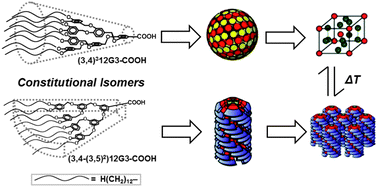From structure to function via complex supramolecular dendrimer systems
Abstract
This tutorial review summarizes strategies elaborated for the discovery and prediction of programmed primary structures derived from quasi-equivalent constitutional isomeric libraries of self-assembling dendrons, dendrimers and dendronized polymers. These libraries demonstrate an 82% predictability, defined as the percentage of similar primary structures resulting in at least one conserved supramolecular shape with internal order. A combination of structural and retrostructural analysis that employs methodologies transplanted from structural biology, adapted to giant supramolecular assemblies was used for this process. A periodic table database of programmed primary structures was elaborated and used to facilitate the emergence of a diversity of functions in complex dendrimer systems via first principles. Assemblies generated by supramolecular and covalent polymer backbones were critically compared. Although by definition complex functional systems cannot be designed, this tutorial hints to a methodology based on database analysis principles to facilitate design principles that may help to mediate an accelerated emergence of chemical, physical and most probably also societal, political and economic complex systems on a shorter time scale and lower cost than by the current methods. This tutorial review is limited to the simplest, synthetically most accessible self-assembling minidendrons, minidendrimers and polymers dendronized with minidendrons that are best analyzed and elucidated at molecular, supramolecular and theoretical levels, and most used in other laboratories. These structures are all interrelated, and their principles expand in a simple way to their higher generations.

- This article is part of the themed collection: Dendrimers and Hyperbranched Polymers

 Please wait while we load your content...
Please wait while we load your content...